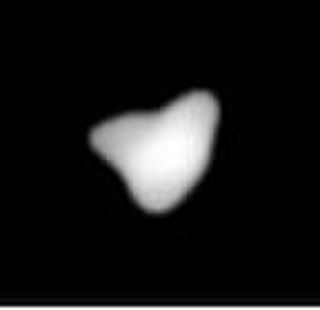
30 Urania is a large main-belt asteroid that was discovered by English astronomer John Russell Hind on July 22, 1854. It was his last asteroid discovery. This object is named after Urania, the Greek Muse of astronomy. Initial orbital elements for 30 Urania were published by Wilhelm Günther, an assistant at Breslau Observatory. It is orbiting the Sun with a period of 3.64 years and is spinning on its axis once every 13.7 hours.

38 Leda is a large, dark main-belt asteroid that was discovered by French astronomer J. Chacornac on January 12, 1856, and named after Leda, the mother of Helen of Troy in Greek mythology. In the Tholen classification system, it is categorized as a carbonaceous C-type asteroid, while the Bus asteroid taxonomy system lists it as a Cgh asteroid. The spectra of the asteroid displays evidence of aqueous alteration.

96 Aegle is a carbonaceous asteroid and the namesake of the Aegle family located in the outer regions of the asteroid belt, approximately 170 kilometers in diameter. It was discovered on 17 February 1868, by French astronomer Jérôme Coggia at the Marseille Observatory in southeastern France. The rare T-type asteroid has a rotation period of 13.8 hours and has been observed several times during occultation events. It was named after Aegle ("brightness"), one of the Hesperides from Greek mythology.

99 Dike is a quite large and dark main-belt asteroid. Dike was discovered by Alphonse Borrelly on May 28, 1868. It was his first asteroid discovery. This object is named after Dike, the Greek goddess of moral justice. Among the first hundred numbered minor planets, 99 Dike was considered anomalously faint for over a century. However, this was later found to be untrue.
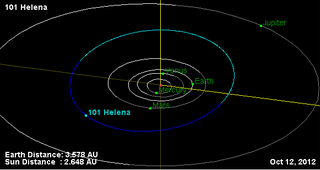
101 Helena is a large, rocky main-belt asteroid. It was discovered by Canadian-American astronomer J. C. Watson on August 15, 1868, and was named after Helen of Troy in Greek mythology.

103 Hera is a moderately large main-belt asteroid with an orbital period of 4.44 years. It was discovered by Canadian-American astronomer James Craig Watson on September 7, 1868, and named after Hera, queen and fifth in power of the Olympian gods in Greek mythology. This is a stony S-type asteroid with a silicate surface composition.

105 Artemis is a main-belt asteroid that was discovered by J. C. Watson on September 16, 1868, at Ann Arbor, Michigan. It was named after Artemis, the goddess of the hunt, Moon, and crossways in Greek Mythology.

108 Hecuba is a fairly large and bright main-belt asteroid. It was discovered by Karl Theodor Robert Luther on 2 April 1869, and named after Hecuba, wife of King Priam in the legends of the Trojan War in Greek Mythology. This object is orbiting the Sun with a period of 5.83 years and an eccentricity of 0.06. It became the first asteroid discovered to orbit near a 2:1 mean-motion resonance with the planet Jupiter, and is the namesake of the Hecuba group of asteroids.

111 Ate is a main-belt asteroid discovered by the German-American astronomer C. H. F. Peters on August 14, 1870, and named after Ate, the goddess of mischief and destruction in Greek mythology. In the Tholen classification system, it is categorized as a carbonaceous C-type asteroid, while the Bus asteroid taxonomy system lists it as an Ch asteroid.
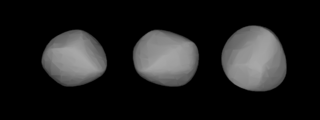
115 Thyra is a fairly large and bright inner main-belt asteroid that was discovered by Canadian-American astronomer J. C. Watson on August 6, 1871 and was named for Thyra, the consort of King Gorm the Old of Denmark. Based upon its spectrum, it is categorized as a stony S-type asteroid.
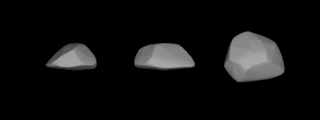
119 Althaea is a main-belt asteroid that was discovered by Canadian-American astronomer J. C. Watson on April 3, 1872, and named after Althaea, the mother of Meleager in Greek mythology. Two occultations by Althaea were observed in 2002, only a month apart.

133 Cyrene is a fairly large and very bright main-belt asteroid that was discovered by J. C. Watson on 16 August 1873 in Ann Arbor, Michigan, and named after Cyrene, a nymph, daughter of king Hypseus and beloved of Apollo in Greek mythology. It is classified as an S-type asteroid based upon its spectrum. It is listed as a member of the Hecuba group of asteroids that orbit near the 2:1 mean-motion resonance with Jupiter.
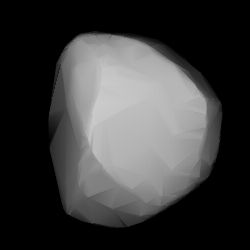
150 Nuwa is a large main-belt asteroid with an orbital period of 5.15 years. It was discovered by Canadian-American astronomer James Craig Watson on October 18, 1875, and named after Nüwa, the Chinese creator goddess. This object is a candidate member of the Hecuba group of asteroids that orbit near the 2:1 mean-motion resonance with Jupiter. Based upon the spectrum it is classified as a C-type asteroid, which indicates that it is probably composed of primitive carbonaceous chondritic material and the surface is exceedingly dark.

158 Koronis is a main-belt asteroid that was discovered by Russian astronomer Viktor Knorre on January 4, 1876, from the Berlin observatory. It was the first of his four asteroid discoveries. The meaning of the asteroid name is uncertain, but it may come from Coronis the mother of Asclepius from Greek mythology. Alternatively, it may come from Coronis, a nymph of the Hyades sisterhood. The Koronis family is named after this asteroid.

160 Una is a fairly large and dark, primitive Main belt asteroid that was discovered by German-American astronomer C. H. F. Peters on February 20, 1876, in Clinton, New York. It is named after a character in Edmund Spenser's epic poem The Faerie Queene (1590).

170 Maria is a Main belt asteroid that was discovered by French astronomer Henri Joseph Perrotin on January 10, 1877. Its orbit was computed by Antonio Abetti, and the asteroid was named after his sister, Maria. This is the namesake of the Maria asteroid family; one of the first asteroid families to be identified by Japanese astronomer Kiyotsugu Hirayama in 1918.

181 Eucharis is a large, slowly rotating main-belt asteroid that was discovered by French astronomer Pablo Cottenot on February 2, 1878, from Marseille Observatory. It was his only asteroid discovery. This object was named after Eucharis, a nymph from the 17th-century novel Les Aventures de Télémaque.
716 Berkeley is a background asteroid from the central regions of the asteroid belt. It was discovered by Austrian astronomer Johann Palisa at the Vienna Observatory on 30 July 1911. The stony S-type asteroid has a rotation period of 15.6 hours and measures approximately 21 kilometers in diameter. It was named after the city of Berkeley, California, where the discoverer's colleague Armin Otto Leuschner (1868–1953) was the director of the local observatory.

908 Buda is a background asteroid from the inner regions of the asteroid belt, approximately 30 kilometers in diameter. It was discovered by German astronomer Max Wolf at the Heidelberg Observatory on 30 November 1918. The uncommon L-type asteroid has a rotation period of 14.6 hours. It was named after Buda, the smaller part of the Hungarian city of Budapest.
1143 Odysseus, provisional designation 1930 BH, is a large Jupiter trojan located in the Greek camp of Jupiter's orbit. It was discovered on 28 January 1930, by German astronomer Karl Reinmuth at the Heidelberg Observatory in southwest Germany, and later named after Odysseus, the legendary hero from Greek mythology. The dark D-type asteroid has a rotation period of 10.1 hours. With a diameter of approximately 125 kilometers, it is among the 10 largest Jovian trojans.


















